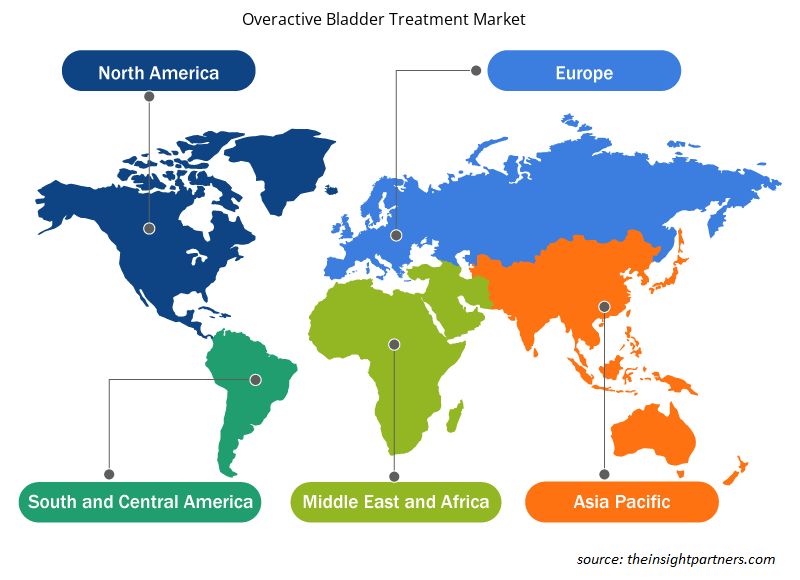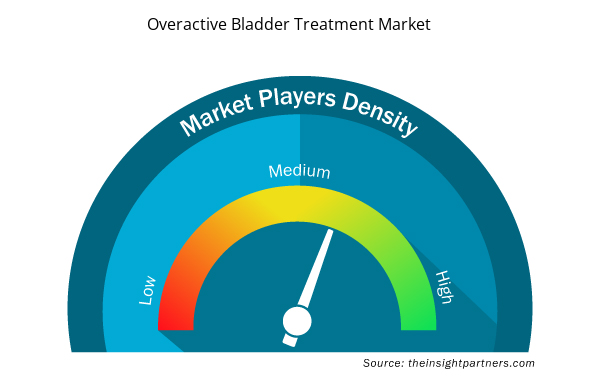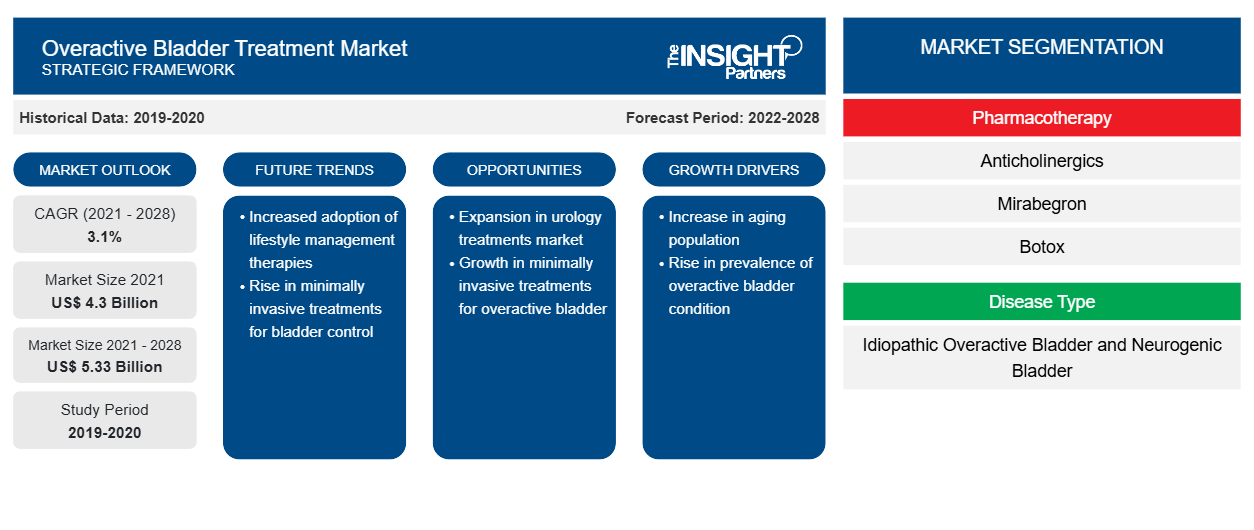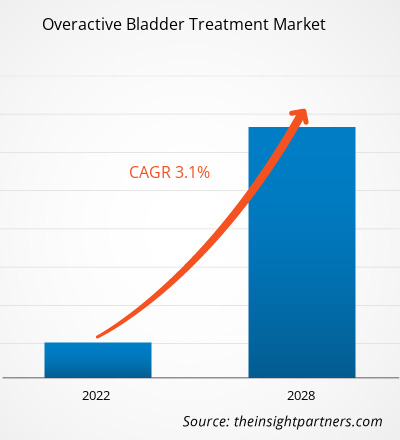Der Markt für die Behandlung einer überaktiven Blase soll von 4.295,93 Millionen US-Dollar im Jahr 2021 auf 5.333,92 Millionen US-Dollar im Jahr 2028 wachsen; von 2022 bis 2028 wird mit einer durchschnittlichen jährlichen Wachstumsrate von 3,1 % gerechnet.
Eine überaktive Blase (OAB) ist ein häufiger und plötzlicher Harndrang, der schwer zu kontrollieren sein kann. Eine OAB kann durch ein Bauchtrauma, eine Infektion, Nervenschäden und bestimmte Medikamente verursacht werden. Eine OAB tritt häufig bei Menschen ab 65 Jahren auf. Frauen können auch nach dem 45. Lebensjahr an einer OAB leiden. Die Behandlung umfasst Verhaltensänderungen, Medikamente und Nervenstimulation.
Der Markt für die Behandlung von überaktiver Blase ist nach Pharmakotherapie, Krankheitstyp und Geografie segmentiert. Geografisch ist der Markt grob in Nordamerika, Europa, Asien-Pazifik, den Nahen Osten und Afrika sowie Süd- und Mittelamerika segmentiert. Der Marktbericht zur Behandlung von überaktiver Blase bietet Einblicke und eine eingehende Analyse des Marktes und betont Parameter wie Markttrends, Marktdynamik und die Wettbewerbsanalyse der weltweit führenden Marktteilnehmer.
Passen Sie diesen Bericht Ihren Anforderungen an
Sie erhalten kostenlos individuelle Anpassungen an jedem Bericht, einschließlich Teilen dieses Berichts oder einer Analyse auf Länderebene, eines Excel-Datenpakets sowie tolle Angebote und Rabatte für Start-ups und Universitäten.
- Holen Sie sich die wichtigsten Markttrends aus diesem Bericht.Dieses KOSTENLOSE Beispiel umfasst eine Datenanalyse von Markttrends bis hin zu Schätzungen und Prognosen.
Markteinblicke
Laut Angaben der National Association for Incontinence waren im Jahr 2018 weltweit etwa 200 Millionen Menschen von Harninkontinenz betroffen. Belastungsinkontinenz und Dranginkontinenz sind die beiden häufigsten Arten von Harninkontinenz bei Frauen, wobei letztere auch als überaktive Blase bezeichnet wird. Eine Studie einer Forschergruppe des American College of Physicians und der Infectious Diseases Society of America aus dem Jahr 2020 ergab, dass Harnwegsinfektionen (HWI) in den USA jedes Jahr die Ursache für etwa 6 Millionen Arztbesuche sind. In Kanada erfolgen jährlich etwa 500.000 Arztbesuche wegen HWI. HWI sind der acht- und fünfthäufigste Grund für ambulante Klinikbesuche bzw. Besuche in der Notaufnahme im Land. Die zunehmende Verbreitung von Harninkontinenz und die zunehmende Inzidenz von Harnwegsinfektionen treiben also den Markt für Behandlungen gegen überaktive Blase an.
Nachfolgend sind einige Beispiele für die Markteinführung und Zulassung neuer Produkte aufgeführt:
- Im Februar 2022 erhielt Alembic Pharmaceuticals von der US-Gesundheitsbehörde die Zulassung für seine generische Version von Fesoterodinfumarat-Retardtabletten, die bei überaktiver Blase bei Erwachsenen mit Symptomen wie Harninkontinenz, Harndrang und häufigem Harnfluss eingesetzt werden. Die Zulassung der US-amerikanischen Food & Drug Administration (USFDA) für den verkürzten Zulassungsantrag (ANDA) für Fesoterodinfumarat-Retardtabletten gilt für die Stärken 4 mg und 8 mg.
- Im April 2022 kündigte Axonics, Inc., ein globales Medizintechnikunternehmen, das neuartige Produkte zur Behandlung von Blasen- und Darmfunktionsstörungen entwickelt und vermarktet, die umfassende Markteinführung des Axonics F15 in den gesamten USA an. Das neu entwickelte, langlebige, vollständig aufladbare sakrale Neuromodulationssystem (SNM) erhielt im März die FDA-Zulassung. Das aufladbare System von Axonics ist ein willkommener Fortschritt für Patienten mit Blasen- und Darmfunktionsstörungen.
- Im März 2021 wurden Myrbetriq von Astellas Pharma – zur Behandlung einer neurogenen Detrusorüberaktivität (NDO) bei pädiatrischen Patienten ab drei Jahren (mit einem Körpergewicht von 35 kg oder mehr) – und Myrbetriq-Granulat – zur Behandlung von NDO bei pädiatrischen Patienten ab drei Jahren – von der US-amerikanischen Food and Drug Administration (FDA) zugelassen.
Solche Produktentwicklungen von Marktakteuren treiben den Markt für die Behandlung überaktiver Blasen an.
Typ-Einblicke
Basierend auf der Pharmakotherapie ist der Markt für die Behandlung einer überaktiven Blase in Mirabegron, Botox, Neurostimulation , Anticholinergika und intravesikale Instillation segmentiert. Das Mirabegron-Segment hielt 2021 den größten Marktanteil und wird im Prognosezeitraum voraussichtlich die höchste CAGR verzeichnen. Mirabegron wird allein oder mit Solifenacin zur Behandlung einer überaktiven Blase bei Erwachsenen verwendet. Es wird zur Behandlung einer neurogenen Detrusorüberaktivität (eine Blasenkontrollstörung, die durch ein Problem des Gehirns, des Rückenmarks oder der Nerven verursacht wird) bei Kindern ab drei Jahren verwendet. Mirabegron gehört zur Klasse der Beta-3-Adrenozeptoragonisten. Es entspannt die Blasenmuskulatur, um dringendes, häufiges oder unkontrolliertes Wasserlassen zu verhindern. Mirabegron ist als Retardtablette (lang wirkend) und als Retardsuspension zur oralen Einnahme erhältlich. Im Oktober 2022 erhielt Zydus Pharmaceuticals Inc. von der USFDA die Zulassung zur Vermarktung von Mirabegron Retardtabletten USP 25 mg und 50 mg. Die steigende Nachfrage nach dieser Therapie dürfte das Wachstum des Marktes für die Behandlung überaktiver Blasen im Prognosezeitraum ankurbeln.
Serviceeinblicke
Basierend auf der Pharmakotherapie ist der Markt für die Behandlung überaktiver Blasen in Mirabegron, Botox, Neurostimulation, Anticholinergika und intravesikale Instillation unterteilt. Das Segment Neurostimulation wird im Prognosezeitraum voraussichtlich die höchste durchschnittliche jährliche Wachstumsrate (CAGR) auf dem Markt verzeichnen. Die neurologische Kontrolle der Blase ist komplex und hängt von verschiedenen Spinal-, Zentral- und peripheren Nerven und ihren zahlreichen Reflexbahnen ab. Die neurologische Kontrolle wird an verschiedenen Stellen des menschlichen Körpers durchgeführt und zielt daher auf verschiedene Nerven ab. Einige dieser Zielnerven sind direkt an der sensorisch-motorischen Kontrolle der unteren Harnwege beteiligt, wie z. B. die Sakral- oder Pudendusnerven, während andere eher indirekt beteiligt sind. Durch elektrische Stimulation werden diese Nerven aktiviert, um die Blase zu kontrollieren.
Partnerschaften und Kooperationen sind bei den Akteuren auf dem globalen Markt für Behandlungen überaktiver Blasen weit verbreitete Strategien. Nachfolgend sind einige der jüngsten wichtigen Marktentwicklungen aufgeführt:
- Im April 2021 gab Medtronic plc die Genehmigung der US-amerikanischen Food and Drug Administration (FDA) bekannt, mit einer Ausnahmegenehmigung für Prüfvorrichtungen (IDE) fortzufahren, um sein intern entwickeltes implantierbares Tibia-Neuromodulationsgerät (TNM) zu evaluieren, eine Therapie zur Linderung der Symptome von Blaseninkontinenz.
- Im Juli 2020 gab Hisamitsu Pharmaceutical Co., Inc. die Genehmigung zur Herstellung und Vermarktung von OABLOK PATCH in Thailand bekannt. Das Produkt ist eine systemische transdermale Formulierung, die unter Verwendung der Transdermal Drug Delivery System (TDDS)-Technologie von Hisamitsu zur Behandlung überaktiver Blasen mit Symptomen wie Harndrang und häufigem Wasserlassen entwickelt wurde.
- Im Juli 2019 brachte Teva Pharmaceuticals Ltd. Solifenacinsuccinat-Tabletten auf den Markt, Muskarinantagonisten zur Behandlung einer überaktiven Blase mit Symptomen wie Harninkontinenz und erhöhter Harnfrequenz.
Die COVID-19-Pandemie hat einige günstige Szenarien für Akteure auf dem Markt für Behandlungen der überaktiven Blase gezeigt. Die USA waren das am stärksten betroffene Land in Nordamerika. Die Infektion hat die geriatrische Bevölkerung des Landes schwer getroffen, verschiedene Komplikationen verursacht und zum Tod einer großen Bevölkerung geführt. So meldeten die USA am 16. Mai 2022 84.230.829 COVID-Fälle mit 1.026.670 Todesfällen. Daher sind eine Behandlung der überaktiven Blase und eine angemessene Pflege erforderlich, um chronischen Infektionsfällen und Gesundheitszuständen vorzubeugen.
Nach dem Ausbruch von COVID-19 ist die Zahl der Fälle von OAB gestiegen. Einer Studie der American Urological Association zufolge haben Patienten mit COVID-19-Infektionen ein erhöhtes Risiko, neue oder sich verschlimmernde Symptome einer überaktiven Blase zu entwickeln. Darüber hinaus berichtete etwa ein Drittel der Patienten mit COVID-19 während des International Consultation on Incontinence Questionnaire Overactive Bladder Module (ICIQ-OAB), das zwei Monate nach der Infektion durchgeführt wurde, von einer signifikanten Zunahme der klinischen Symptome. Von diesem Drittel der Patienten gab etwa jeder Fünfte an, dass seine OAB-Symptome neu aufgetreten seien. Diese erhöhte Prävalenz von OAB aufgrund von COVID-19 wirkte sich positiv auf die Nachfrage nach Behandlungen für überaktive Blasen während der Pandemie aus.
Regionale Einblicke in den Markt für die Behandlung überaktiver Blasen
Die regionalen Trends und Faktoren, die den Markt für die Behandlung von überaktiver Blase während des gesamten Prognosezeitraums beeinflussen, wurden von den Analysten von Insight Partners ausführlich erläutert. In diesem Abschnitt werden auch Marktsegmente und Geografien für die Behandlung von überaktiver Blase in Nordamerika, Europa, im asiatisch-pazifischen Raum, im Nahen Osten und Afrika sowie in Süd- und Mittelamerika erörtert.

- Erhalten Sie regionale Daten zum Markt für die Behandlung überaktiver Blasen
Umfang des Marktberichts zur Behandlung überaktiver Blase
| Berichtsattribut | Details |
|---|---|
| Marktgröße im Jahr 2021 | 4,3 Milliarden US-Dollar |
| Marktgröße bis 2028 | 5,33 Milliarden US-Dollar |
| Globale CAGR (2021 - 2028) | 3,1 % |
| Historische Daten | 2019-2020 |
| Prognosezeitraum | 2022–2028 |
| Abgedeckte Segmente | Durch Pharmakotherapie
|
| Abgedeckte Regionen und Länder | Nordamerika
|
| Marktführer und wichtige Unternehmensprofile |
|
Marktteilnehmerdichte bei der Behandlung überaktiver Blase: Auswirkungen auf die Geschäftsdynamik verstehen
Der Markt für Behandlungen bei überaktiver Blase wächst rasant. Dies wird durch die steigende Nachfrage der Endnutzer aufgrund von Faktoren wie sich entwickelnden Verbraucherpräferenzen, technologischen Fortschritten und einem größeren Bewusstsein für die Vorteile des Produkts vorangetrieben. Mit der steigenden Nachfrage erweitern Unternehmen ihr Angebot, entwickeln Innovationen, um die Bedürfnisse der Verbraucher zu erfüllen, und nutzen neue Trends, was das Marktwachstum weiter ankurbelt.
Die Marktteilnehmerdichte bezieht sich auf die Verteilung der Firmen oder Unternehmen, die in einem bestimmten Markt oder einer bestimmten Branche tätig sind. Sie gibt an, wie viele Wettbewerber (Marktteilnehmer) in einem bestimmten Marktraum im Verhältnis zu seiner Größe oder seinem gesamten Marktwert präsent sind.
Die wichtigsten Unternehmen auf dem Markt für die Behandlung überaktiver Blasen sind:
- Alembic Pharmaceuticals Limited
- Astellas Pharma Inc
- Pfizer Inc
- AbbVie Inc
- Teva Pharmaceutical Industries Ltd
Haftungsausschluss : Die oben aufgeführten Unternehmen sind nicht in einer bestimmten Reihenfolge aufgeführt.

- Überblick über die wichtigsten Akteure auf dem Markt für die Behandlung überaktiver Blase
Behandlung einer überaktiven Blase – Marktsegmentierung
Der globale Markt für die Behandlung überaktiver Blasen wird anhand von Pharmakotherapie, Krankheitstyp und Geografie analysiert. Basierend auf der Pharmakotherapie wird der Markt für die Behandlung überaktiver Blasen in Mirabegron, Botox, Neurostimulation, Anticholinergika und intravesikale Instillation unterteilt. Basierend auf dem Krankheitstyp wird der Markt in idiopathische überaktive Blase und neurogene Blase unterteilt. Geografisch ist der Markt für die Behandlung überaktiver Blasen in Nordamerika, Europa, Asien-Pazifik, den Nahen Osten und Afrika sowie Süd- und Mittelamerika unterteilt.
Firmenprofile
- Alembic Pharmaceuticals Limited
- Astellas Pharma Inc
- AbbVie Inc
- Teva Pharmaceuticals Industries Ltd
- Endo Pharmaceuticals Inc
- Hisamitsu Pharmaceutical Co. Inc
- Medtronic Plc
- Colorado Urology Associates, PLLC
- Axonics Modulation Technologies, Inc
- Pfizer Inc
- Historische Analyse (2 Jahre), Basisjahr, Prognose (7 Jahre) mit CAGR
- PEST- und SWOT-Analyse
- Marktgröße Wert/Volumen – Global, Regional, Land
- Branche und Wettbewerbsumfeld
- Excel-Datensatz


- Quantitative Structure-Activity Relationship (QSAR) Market
- 3D Audio Market
- Sexual Wellness Market
- Genetic Testing Services Market
- Drain Cleaning Equipment Market
- Integrated Platform Management System Market
- Point of Care Diagnostics Market
- Dairy Flavors Market
- Health Economics and Outcome Research (HEOR) Services Market
- Maritime Analytics Market

Report Coverage
Revenue forecast, Company Analysis, Industry landscape, Growth factors, and Trends

Segment Covered
This text is related
to segments covered.

Regional Scope
North America, Europe, Asia Pacific, Middle East & Africa, South & Central America

Country Scope
This text is related
to country scope.
Häufig gestellte Fragen
The factors that are driving the growth of the overactive bladder treatment market are urinary tract infections (UTI) which lead to increased activity in the bladder wall muscles, causing symptoms like an overactive bladder. The bacteria causing UTIs reside in the lining of urothelial cells, and they attack the host body when their innate immunity is low. Individuals with recurrent UTIs are found to have voiding dysfunction and detrusor overactivity, and these functional abnormalities may further damage the integrity of the urothelial barrier. The increasing prevalence of UTIs, coupled with the association of UTIs with overactive bladder, is one of the prominent factors contributing to the overactive bladder treatment market growth.
The CAGR value of the overactive bladder treatment market during the forecasted period of 2022-2028 is 3.1%.
The overactive bladder treatment market is estimated to be valued at US$ 4,295.93 million in 2021.
The overactive bladder treatment market is expected to be valued at US$ 5,333.92 million in 2028.
The overactive bladder treatment market majorly consists of the players, such as Alembic Pharmaceuticals Limited, Astellas Pharma Inc; Pfizer Inc; AbbVie Inc; Teva Pharmaceutical Industries Ltd; Endo Pharmaceuticals Inc; Hisamitsu Pharmaceutical Co., Inc; Medtronic Plc; Colorado Urology Associates, PLLC; Axonics Modulation Technologies, Inc.
The mirabegron segment held the largest share of the market in 2021. However, neurostimulation is expected to grow at the highest CAGR during the forecast period.
The Asia Pacific is expected to be the fastest-growing region in the overactive bladder treatment market over the forecast period due to the rising geriatric population, increasing urinary incontinence cases, and a surge in product launches.
The sudden need to urinate causes a problem with bladder dysfunction. An overactive bladder may affect how often you pee and your urgency. Causes include abdominal trauma, infection, nerve damage, medications, and certain fluids. Treatment includes changing certain behaviors, medications, and nerve stimulation. Overactive bladder is common in people aged 65 and older. Women may have OAB at a younger age, usually around 45.
Trends and growth analysis reports related to Life Sciences : READ MORE..
The List of Companies -Overactive Bladder Treatment Market
- Alembic Pharmaceuticals Limited
- Astellas Pharma Inc
- Pfizer Inc
- AbbVie Inc
- Teva Pharmaceutical Industries Ltd
- Endo Pharmaceuticals Inc.
- Hisamitsu Pharmaceutical Co.,Inc
- Medtronic Plc
- Colorado Urology Associates, PLLC
- Axonics Modulation Technologies, Inc
The Insight Partners performs research in 4 major stages: Data Collection & Secondary Research, Primary Research, Data Analysis and Data Triangulation & Final Review.
- Data Collection and Secondary Research:
As a market research and consulting firm operating from a decade, we have published and advised several client across the globe. First step for any study will start with an assessment of currently available data and insights from existing reports. Further, historical and current market information is collected from Investor Presentations, Annual Reports, SEC Filings, etc., and other information related to company’s performance and market positioning are gathered from Paid Databases (Factiva, Hoovers, and Reuters) and various other publications available in public domain.
Several associations trade associates, technical forums, institutes, societies and organization are accessed to gain technical as well as market related insights through their publications such as research papers, blogs and press releases related to the studies are referred to get cues about the market. Further, white papers, journals, magazines, and other news articles published in last 3 years are scrutinized and analyzed to understand the current market trends.
- Primary Research:
The primarily interview analysis comprise of data obtained from industry participants interview and answers to survey questions gathered by in-house primary team.
For primary research, interviews are conducted with industry experts/CEOs/Marketing Managers/VPs/Subject Matter Experts from both demand and supply side to get a 360-degree view of the market. The primary team conducts several interviews based on the complexity of the markets to understand the various market trends and dynamics which makes research more credible and precise.
A typical research interview fulfils the following functions:
- Provides first-hand information on the market size, market trends, growth trends, competitive landscape, and outlook
- Validates and strengthens in-house secondary research findings
- Develops the analysis team’s expertise and market understanding
Primary research involves email interactions and telephone interviews for each market, category, segment, and sub-segment across geographies. The participants who typically take part in such a process include, but are not limited to:
- Industry participants: VPs, business development managers, market intelligence managers and national sales managers
- Outside experts: Valuation experts, research analysts and key opinion leaders specializing in the electronics and semiconductor industry.
Below is the breakup of our primary respondents by company, designation, and region:

Once we receive the confirmation from primary research sources or primary respondents, we finalize the base year market estimation and forecast the data as per the macroeconomic and microeconomic factors assessed during data collection.
- Data Analysis:
Once data is validated through both secondary as well as primary respondents, we finalize the market estimations by hypothesis formulation and factor analysis at regional and country level.
- Macro-Economic Factor Analysis:
We analyse macroeconomic indicators such the gross domestic product (GDP), increase in the demand for goods and services across industries, technological advancement, regional economic growth, governmental policies, the influence of COVID-19, PEST analysis, and other aspects. This analysis aids in setting benchmarks for various nations/regions and approximating market splits. Additionally, the general trend of the aforementioned components aid in determining the market's development possibilities.
- Country Level Data:
Various factors that are especially aligned to the country are taken into account to determine the market size for a certain area and country, including the presence of vendors, such as headquarters and offices, the country's GDP, demand patterns, and industry growth. To comprehend the market dynamics for the nation, a number of growth variables, inhibitors, application areas, and current market trends are researched. The aforementioned elements aid in determining the country's overall market's growth potential.
- Company Profile:
The “Table of Contents” is formulated by listing and analyzing more than 25 - 30 companies operating in the market ecosystem across geographies. However, we profile only 10 companies as a standard practice in our syndicate reports. These 10 companies comprise leading, emerging, and regional players. Nonetheless, our analysis is not restricted to the 10 listed companies, we also analyze other companies present in the market to develop a holistic view and understand the prevailing trends. The “Company Profiles” section in the report covers key facts, business description, products & services, financial information, SWOT analysis, and key developments. The financial information presented is extracted from the annual reports and official documents of the publicly listed companies. Upon collecting the information for the sections of respective companies, we verify them via various primary sources and then compile the data in respective company profiles. The company level information helps us in deriving the base number as well as in forecasting the market size.
- Developing Base Number:
Aggregation of sales statistics (2020-2022) and macro-economic factor, and other secondary and primary research insights are utilized to arrive at base number and related market shares for 2022. The data gaps are identified in this step and relevant market data is analyzed, collected from paid primary interviews or databases. On finalizing the base year market size, forecasts are developed on the basis of macro-economic, industry and market growth factors and company level analysis.
- Data Triangulation and Final Review:
The market findings and base year market size calculations are validated from supply as well as demand side. Demand side validations are based on macro-economic factor analysis and benchmarks for respective regions and countries. In case of supply side validations, revenues of major companies are estimated (in case not available) based on industry benchmark, approximate number of employees, product portfolio, and primary interviews revenues are gathered. Further revenue from target product/service segment is assessed to avoid overshooting of market statistics. In case of heavy deviations between supply and demand side values, all thes steps are repeated to achieve synchronization.
We follow an iterative model, wherein we share our research findings with Subject Matter Experts (SME’s) and Key Opinion Leaders (KOLs) until consensus view of the market is not formulated – this model negates any drastic deviation in the opinions of experts. Only validated and universally acceptable research findings are quoted in our reports.
We have important check points that we use to validate our research findings – which we call – data triangulation, where we validate the information, we generate from secondary sources with primary interviews and then we re-validate with our internal data bases and Subject matter experts. This comprehensive model enables us to deliver high quality, reliable data in shortest possible time.


 Holen Sie sich ein kostenloses Muster für diesen Bericht
Holen Sie sich ein kostenloses Muster für diesen Bericht